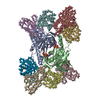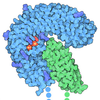+ Open data
Open data
- Basic information
Basic information
| Entry | Database: PDB / ID: 9bcq | ||||||
|---|---|---|---|---|---|---|---|
| Title | Extracellular domain of GC-A bound to ANP | ||||||
 Components Components | (Atrial natriuretic ...) x 2 | ||||||
 Keywords Keywords | LYASE / Single pass transmembrane protein / guanylyl cyclase / atrial natriuretic peptide receptor / hypertension / membrane protein | ||||||
| Function / homology |  Function and homology information Function and homology informationnegative regulation of collecting lymphatic vessel constriction / : / ANPR-A receptor complex / natriuretic peptide receptor activity / : / neuropeptide receptor binding / : / mast cell granule / response to 3-methylcholanthrene / receptor guanylyl cyclase signaling pathway ...negative regulation of collecting lymphatic vessel constriction / : / ANPR-A receptor complex / natriuretic peptide receptor activity / : / neuropeptide receptor binding / : / mast cell granule / response to 3-methylcholanthrene / receptor guanylyl cyclase signaling pathway / body fluid secretion / positive regulation of potassium ion export across plasma membrane / peptide receptor activity / positive regulation of renal sodium excretion / guanylate cyclase / cell growth involved in cardiac muscle cell development / synaptic signaling via neuropeptide / cGMP biosynthetic process / guanylate cyclase activity / negative regulation of JUN kinase activity / regulation of atrial cardiac muscle cell membrane repolarization / Physiological factors / cardiac conduction system development / YAP1- and WWTR1 (TAZ)-stimulated gene expression / sodium ion export across plasma membrane / regulation of vascular permeability / neuropeptide hormone activity / positive regulation of urine volume / hormone receptor binding / negative regulation of systemic arterial blood pressure / glycinergic synapse / cardiac muscle hypertrophy in response to stress / G protein-coupled peptide receptor activity / aortic valve morphogenesis / regulation of calcium ion transmembrane transport via high voltage-gated calcium channel / : / dopamine metabolic process / hormone binding / peptide hormone binding / brush border / cellular response to angiotensin / neuropeptide signaling pathway / positive regulation of heart rate / response to muscle stretch / positive regulation of cardiac muscle contraction / negative regulation of angiogenesis / blood vessel diameter maintenance / cell projection / negative regulation of smooth muscle cell proliferation / cellular response to mechanical stimulus / female pregnancy / negative regulation of cell growth / response to insulin / hormone activity / regulation of blood pressure / vasodilation / cellular response to hydrogen peroxide / protein folding / : / perikaryon / response to hypoxia / cell surface receptor signaling pathway / receptor complex / protein kinase activity / Amyloid fiber formation / signaling receptor binding / GTP binding / perinuclear region of cytoplasm / protein-containing complex / extracellular space / extracellular region / ATP binding / plasma membrane / cytoplasm Similarity search - Function | ||||||
| Biological species |  Homo sapiens (human) Homo sapiens (human) | ||||||
| Method | ELECTRON MICROSCOPY / single particle reconstruction / cryo EM / Resolution: 3.1 Å | ||||||
 Authors Authors | Liu, S. / Huang, X. | ||||||
| Funding support |  United States, 1items United States, 1items
| ||||||
 Citation Citation |  Journal: Nat Struct Mol Biol / Year: 2025 Journal: Nat Struct Mol Biol / Year: 2025Title: Architecture and activation of single-pass transmembrane receptor guanylyl cyclase. Authors: Shian Liu / Alexander M Payne / Jinan Wang / Lan Zhu / Navid Paknejad / Edward T Eng / Wei Liu / Yinglong Miao / Richard K Hite / Xin-Yun Huang /  Abstract: The heart, in addition to its primary role in blood circulation, functions as an endocrine organ by producing cardiac hormone natriuretic peptides. These hormones regulate blood pressure through the ...The heart, in addition to its primary role in blood circulation, functions as an endocrine organ by producing cardiac hormone natriuretic peptides. These hormones regulate blood pressure through the single-pass transmembrane receptor guanylyl cyclase A (GC-A), also known as natriuretic peptide receptor 1. The binding of the peptide hormones to the extracellular domain of the receptor activates the intracellular guanylyl cyclase domain of the receptor to produce the second messenger cyclic guanosine monophosphate. Despite their importance, the detailed architecture and domain interactions within full-length GC-A remain elusive. Here we present cryo-electron microscopy structures, functional analyses and molecular dynamics simulations of full-length human GC-A, in both the absence and the presence of atrial natriuretic peptide. The data reveal the architecture of full-length GC-A, highlighting the spatial arrangement of its various functional domains. This insight is crucial for understanding how different parts of the receptor interact and coordinate during activation. The study elucidates the molecular basis of how extracellular signals are transduced across the membrane to activate the intracellular guanylyl cyclase domain. | ||||||
| History |
|
- Structure visualization
Structure visualization
| Structure viewer | Molecule:  Molmil Molmil Jmol/JSmol Jmol/JSmol |
|---|
- Downloads & links
Downloads & links
- Download
Download
| PDBx/mmCIF format |  9bcq.cif.gz 9bcq.cif.gz | 313.8 KB | Display |  PDBx/mmCIF format PDBx/mmCIF format |
|---|---|---|---|---|
| PDB format |  pdb9bcq.ent.gz pdb9bcq.ent.gz | 240.2 KB | Display |  PDB format PDB format |
| PDBx/mmJSON format |  9bcq.json.gz 9bcq.json.gz | Tree view |  PDBx/mmJSON format PDBx/mmJSON format | |
| Others |  Other downloads Other downloads |
-Validation report
| Arichive directory |  https://data.pdbj.org/pub/pdb/validation_reports/bc/9bcq https://data.pdbj.org/pub/pdb/validation_reports/bc/9bcq ftp://data.pdbj.org/pub/pdb/validation_reports/bc/9bcq ftp://data.pdbj.org/pub/pdb/validation_reports/bc/9bcq | HTTPS FTP |
|---|
-Related structure data
| Related structure data |  44434MC  9bclC  9bcnC  9bcoC  9bcpC  9bcsC  9bcvC M: map data used to model this data C: citing same article ( |
|---|---|
| Similar structure data | Similarity search - Function & homology  F&H Search F&H Search |
- Links
Links
- Assembly
Assembly
| Deposited unit | 
|
|---|---|
| 1 |
|
- Components
Components
-Atrial natriuretic ... , 2 types, 3 molecules ABC
| #1: Protein | Mass: 116770.852 Da / Num. of mol.: 2 Source method: isolated from a genetically manipulated source Source: (gene. exp.)  Homo sapiens (human) / Gene: NPR1, ANPRA / Production host: Homo sapiens (human) / Gene: NPR1, ANPRA / Production host:  #2: Protein/peptide | | Mass: 3087.505 Da / Num. of mol.: 1 / Fragment: UNP residues 124-151 Source method: isolated from a genetically manipulated source Source: (gene. exp.)  Homo sapiens (human) / Gene: NPPA, ANP, PND / Production host: Homo sapiens (human) / Gene: NPPA, ANP, PND / Production host:  Homo sapiens (human) / References: UniProt: P01160 Homo sapiens (human) / References: UniProt: P01160 |
|---|
-Sugars , 3 types, 5 molecules 
| #3: Polysaccharide | Source method: isolated from a genetically manipulated source #4: Polysaccharide | alpha-D-mannopyranose-(1-3)-2-acetamido-2-deoxy-beta-D-glucopyranose-(1-4)-2-acetamido-2-deoxy-beta- ...alpha-D-mannopyranose-(1-3)-2-acetamido-2-deoxy-beta-D-glucopyranose-(1-4)-2-acetamido-2-deoxy-beta-D-glucopyranose | Source method: isolated from a genetically manipulated source #6: Sugar | ChemComp-NAG / | |
|---|
-Non-polymers , 1 types, 2 molecules 
| #5: Chemical |
|---|
-Details
| Has ligand of interest | Y |
|---|---|
| Has protein modification | Y |
-Experimental details
-Experiment
| Experiment | Method: ELECTRON MICROSCOPY |
|---|---|
| EM experiment | Aggregation state: PARTICLE / 3D reconstruction method: single particle reconstruction |
- Sample preparation
Sample preparation
| Component | Name: Atrial natriuretic peptide receptor 1 dimer / Type: COMPLEX / Entity ID: #1-#2 / Source: MULTIPLE SOURCES |
|---|---|
| Source (natural) | Organism:  Homo sapiens (human) Homo sapiens (human) |
| Source (recombinant) | Organism:  |
| Buffer solution | pH: 8 |
| Specimen | Conc.: 1 mg/ml / Embedding applied: NO / Shadowing applied: NO / Staining applied: NO / Vitrification applied: YES |
| Vitrification | Cryogen name: ETHANE |
- Electron microscopy imaging
Electron microscopy imaging
| Experimental equipment |  Model: Titan Krios / Image courtesy: FEI Company |
|---|---|
| Microscopy | Model: FEI TITAN KRIOS |
| Electron gun | Electron source:  FIELD EMISSION GUN / Accelerating voltage: 300 kV / Illumination mode: FLOOD BEAM FIELD EMISSION GUN / Accelerating voltage: 300 kV / Illumination mode: FLOOD BEAM |
| Electron lens | Mode: BRIGHT FIELD / Nominal defocus max: 2000 nm / Nominal defocus min: 1500 nm |
| Image recording | Electron dose: 51.13 e/Å2 / Film or detector model: GATAN K3 (6k x 4k) |
- Processing
Processing
| CTF correction | Type: PHASE FLIPPING AND AMPLITUDE CORRECTION |
|---|---|
| 3D reconstruction | Resolution: 3.1 Å / Resolution method: FSC 0.143 CUT-OFF / Num. of particles: 964634 / Symmetry type: POINT |
 Movie
Movie Controller
Controller











 PDBj
PDBj







